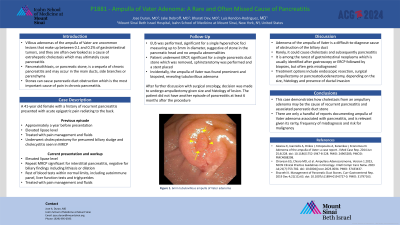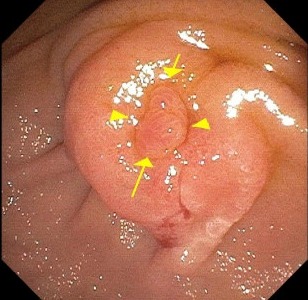Monday Poster Session
Category: Biliary/Pancreas
P1881 - Ampulla of Vater Adenoma: A Rare and Often Missed Cause of Pancreatitis
Monday, October 28, 2024
10:30 AM - 4:00 PM ET
Location: Exhibit Hall E

Has Audio

Jose Duran, MD
Mount Sinai Beth Israel, Icahn School of Medicine at Mount Sinai
New York, NY
Presenting Author(s)
Jose Duran, MD1, Jake DeBroff, MD1, Bharati Dev, DO2, Luis Rendon, MD1
1Mount Sinai Beth Israel, Icahn School of Medicine at Mount Sinai, New York, NY; 2Icahn School of Medicine at Mount Sinai Morningside/West, New York, NY
Introduction:
Villous adenomas of the ampulla of Vater are uncommon lesions that make up between 0.1 and 0.2% of gastrointestinal tumors, and they are often overlooked as a cause of extrahepatic cholestasis which may ultimately cause pancreatitis. Pancreatolithiasis, or pancreatic stone, is a sequela of chronic pancreatitis and may occur in the main ducts, side branches or parenchyma. Stones can cause pancreatic duct obstruction which is the most important cause of pain in chronic pancreatitis.
Case Description/Methods:
A 41-year old female with a history of frequent epigastric pain presented with acute epigastric pain. Last time was approximately a year before presentation, accompanied by elevated lipase, treated with pain management and fluids. The patient underwent cholecystectomy for presumed biliary sludge and cholecystitis seen in MRCP. Current presentation similar to prior and repeat MRCP was significant for interstitial pancreatitis, negative for biliary findings including lithiasis or dilation, or other pancreatic findings. Other blood tests within normal limits, including autoimmune panel, liver function tests and triglycerides. No significant social history or family history of pancreatitis or pancreatic cancer.
Given negative workup and repeated episode of pancreatitis without clear cause, EUS was performed to further evaluate other causes of acute on chronic pancreatitis, significant for a single hyperechoic foci measuring up to 3 mm in diameter, suggestive of stone in the pancreatic head, no ampulla abnormalities. The patient underwent ERCP, significant for a single pancreatic duct stone which was removed, sphincterotomy was performed and a stent placed. Incidentally, the ampulla of Vater was found prominent, and biopsy revealed tubulovillous adenoma. After further discussion with surgical oncology, decision was made to undergo ampullectomy given size and histology of lesion, with no further episodes since.
Discussion:
Adenoma of the ampulla of Vater is a difficult-to-diagnose cause of obstruction of the biliary duct. It is among the rarest of gastrointestinal neoplasms which is usually identified after gastroscopy or ERCP followed by biopsies, but often gets misdiagnosed. This case demonstrates how stasis from an ampullary adenoma may be the cause of repeated pancreatitis and associated pancreatic duct stone. There are only a handful of reports documenting ampulla of Vater adenoma associated with pancreatitis, and is relevant given its rarity, frequency of misdiagnosis and risk for malignancy.

Disclosures:
Jose Duran, MD1, Jake DeBroff, MD1, Bharati Dev, DO2, Luis Rendon, MD1. P1881 - Ampulla of Vater Adenoma: A Rare and Often Missed Cause of Pancreatitis, ACG 2024 Annual Scientific Meeting Abstracts. Philadelphia, PA: American College of Gastroenterology.
1Mount Sinai Beth Israel, Icahn School of Medicine at Mount Sinai, New York, NY; 2Icahn School of Medicine at Mount Sinai Morningside/West, New York, NY
Introduction:
Villous adenomas of the ampulla of Vater are uncommon lesions that make up between 0.1 and 0.2% of gastrointestinal tumors, and they are often overlooked as a cause of extrahepatic cholestasis which may ultimately cause pancreatitis. Pancreatolithiasis, or pancreatic stone, is a sequela of chronic pancreatitis and may occur in the main ducts, side branches or parenchyma. Stones can cause pancreatic duct obstruction which is the most important cause of pain in chronic pancreatitis.
Case Description/Methods:
A 41-year old female with a history of frequent epigastric pain presented with acute epigastric pain. Last time was approximately a year before presentation, accompanied by elevated lipase, treated with pain management and fluids. The patient underwent cholecystectomy for presumed biliary sludge and cholecystitis seen in MRCP. Current presentation similar to prior and repeat MRCP was significant for interstitial pancreatitis, negative for biliary findings including lithiasis or dilation, or other pancreatic findings. Other blood tests within normal limits, including autoimmune panel, liver function tests and triglycerides. No significant social history or family history of pancreatitis or pancreatic cancer.
Given negative workup and repeated episode of pancreatitis without clear cause, EUS was performed to further evaluate other causes of acute on chronic pancreatitis, significant for a single hyperechoic foci measuring up to 3 mm in diameter, suggestive of stone in the pancreatic head, no ampulla abnormalities. The patient underwent ERCP, significant for a single pancreatic duct stone which was removed, sphincterotomy was performed and a stent placed. Incidentally, the ampulla of Vater was found prominent, and biopsy revealed tubulovillous adenoma. After further discussion with surgical oncology, decision was made to undergo ampullectomy given size and histology of lesion, with no further episodes since.
Discussion:
Adenoma of the ampulla of Vater is a difficult-to-diagnose cause of obstruction of the biliary duct. It is among the rarest of gastrointestinal neoplasms which is usually identified after gastroscopy or ERCP followed by biopsies, but often gets misdiagnosed. This case demonstrates how stasis from an ampullary adenoma may be the cause of repeated pancreatitis and associated pancreatic duct stone. There are only a handful of reports documenting ampulla of Vater adenoma associated with pancreatitis, and is relevant given its rarity, frequency of misdiagnosis and risk for malignancy.

Figure: Ampulla of Vater adenoma seen in ERCP
Disclosures:
Jose Duran indicated no relevant financial relationships.
Jake DeBroff indicated no relevant financial relationships.
Bharati Dev indicated no relevant financial relationships.
Luis Rendon indicated no relevant financial relationships.
Jose Duran, MD1, Jake DeBroff, MD1, Bharati Dev, DO2, Luis Rendon, MD1. P1881 - Ampulla of Vater Adenoma: A Rare and Often Missed Cause of Pancreatitis, ACG 2024 Annual Scientific Meeting Abstracts. Philadelphia, PA: American College of Gastroenterology.
